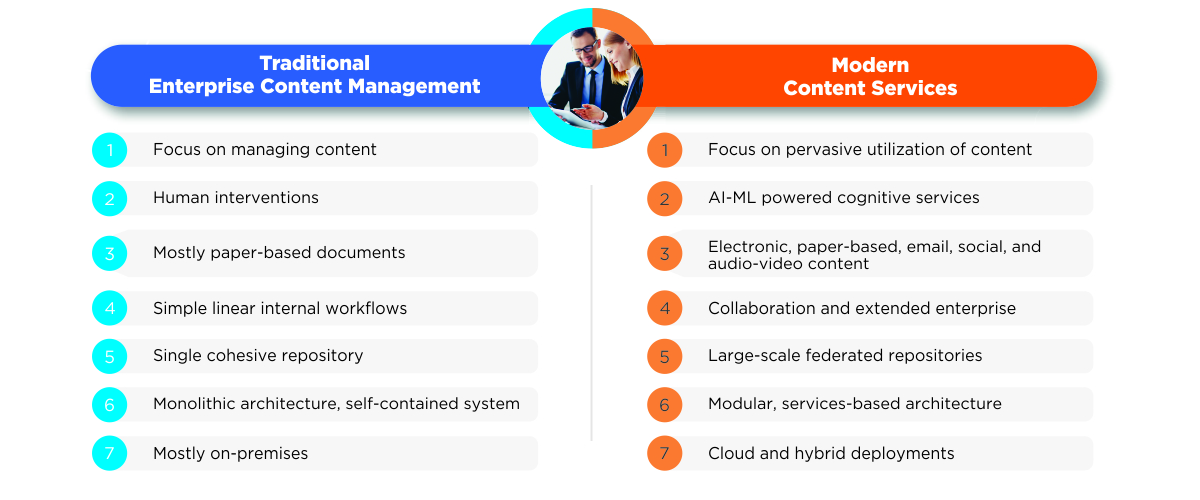Enterprise Content Management
What is Enterprise Content Management?
Enterprise Content Management (ECM) is an all-encompassing term that defines a set of processes and strategies used to capture, manage, and deliver content. Rather than a single technology or procedure, ECM utilizes a combination of methods in order to support the management of critical information. This information can then be distributed to employees, stakeholders, and customers.
Enterprise Content Management software has evolved over the years as new and innovative forms of content are introduced to professional work environments and continues to be a critical function to support business practices.
In traditional ECM software, the definition of content generally referred to any information printed on paper documents such as invoices or reports. That definition has expanded to include any digital information such as email messages, audio and video files, social media posts, and more.
When working with large volumes of content, it is important to implement an ECM to streamline content distribution with workflow automation so that you achieve the full benefits of the platform. With functionalities ranging from capturing content from multiple sources, managing it in a secure, centralized repository, and making information accessible across content-centric processes, Newgen enables business leaders to build a boundaryless workplace with anytime-anywhere content access.
How does ECM work?
Enterprise Content Management describes the approach organizations take in managing the end-to-end lifecycle of their content, from origination to disposition, while providing the flexibility to access and deliver digital content across all channels and devices.
Business leaders must create a connected and digital workplace to empower their employees with contextual information and easy access to content, thereby driving more informed interactions with customers, partners, and stakeholders.
End-users are able to search for specific content within large volumes of structured and unstructured information using full-text natural requests. An ECM system will retrieve it instantly regardless of their device or location. From there, the user may edit, print, read or reformat the content as needed. Enterprise Content Management systems also automate document capture, decreasing the time spent manually scanning and reformatting content.
What are the Components of ECM?
There are two types of content that Enterprise Content Management normally processes: structured and unstructured. Structured content, like code repositories and databases, is data that is pre-defined. Unstructured content is information that doesn’t have a contained format, such as Microsoft Word documents, PDFs, company emails, and presentations.
Organizations can choose between deploying ECM software in the cloud or on-premise. Cloud-based (or SaaS) ECM simplifies mobile and remote access and offers more flexible licensing models. Using in-house information management systems allows more physical control over your content and adds a few additional layers of security.
ECM software can be broken down into five major components: capture, manage, store, preserve and deliver. Each component of ECM plays a significant role in the content management process. Here are basic descriptions of each component:
- Capture: Acquires and delivers data into digital form to help automate data entry tasks and reduce human error
- Manage: Directs and connects data through collaboration and workflow tools to simplify indexing, retention, and purging.
- Store: Stows and categorizes data using a repository, a library tool, and the hardware (servers, cloud-storage, or optical disks.)
- Preserve: Data is backed up and sustained for long-term usage
- Deliver: Approved users are provided with the data they need when they need it
What Are Some Use Cases of ECM?
Newgen’s Enterprise Content Management solutions have positively impacted organizations in many industries. A few Use Cases include:
Human Resources
ECM has obvious benefits in the world of HR. Digital documents are far more easily distributed, tracked, and stored than paper documents. Automated workflows greatly speed up the process of handling everyday business functions related to employee case management. And, of course, the digital transformation of your HR department allows for stronger audit trails.
Banking
Documents for various processes like account opening, loan processing, credit card processing, RTGS, and insurance policy can be archived and managed by Newgen’s ECM suite. This enables streamlined processes between bank branches and the corporate office, ensures the desired economy of scale, increased operational efficiency, and efficient management of document images.
Governmental Records Management
Governments must comply with regulations for archiving and sharing documents securely. A modern ECM enables cost-effective, long-term storage of all types of records, easy tracking of the physical movement of documents and physical records, and compliance with the regulatory requirements to prevent accidental deletion of documents, minimizing risk and enhancing accountability.
How has ECM Evolved?

Why Modernize ECM?
An outdated ECM software can hurt your organization in more ways than you’d think. Enterprise content management modernization is the key to creating an agile, sustainable, and future-proof organization. Listed here are 10 main reasons to modernize ECM:
- Customers expect contextual engagement
- Interactions must be omnichannel
- Content is pervasive and is continuously evolving in its format and scale
- Security, risk, and compliance requirements are constantly changing
- Workforces must be customer-centric, productive, and able to work remotely
- Enterprises must be collaborative-driven
- Operations must be elastic and agile
- Operations require intelligent automation
- Digital business models demand an extended enterprise
- Legacy enterprise content management infrastructure can be extremely difficult to manage and support
Technological advancements, an increase in demand for company efficiency, and an uprise in data breaches are making ECM more important now than ever before. It’s important for organizations to manage content effectively for integration purposes and to help them make effective business decisions.
Company productivity and efficiency increase as their dependency on paper and physical documents decreases. Businesses that don’t implement ECM risk losing valuable time and assets. If disaster strikes, companies that don’t securely store content can lose that information, leading to significant business interruptions.
Advancements in technology, mobile/remote, and cloud technology are creating new opportunities for businesses. New types of content are also emerging in the form of social media, video, and audio. Businesses should adapt to these advancements by implementing ECM software so they can continue to organize data and optimize business performance.
Implementing a Successful ECM Platform
An ECM implementation is a complex process that involves a variety of departments within an organization. Before implementing ECM, it’s important for organizations to develop a strategy to identify their specific priorities and to get clarity on the necessary procedures and technologies their new solution will entail.
Before implementation, businesses should perform a content audit by documenting all the types of content their organization deals with and who handles what data. ECM is collaborative, and multiple departments must be involved in the implementation process. Organizations should create a team-centered around these multiple groups in order to reach success.
Organizations should have a clear understanding of what an ECM implementation will achieve, and the best way to do so is to define goals. Regardless of the industry or department implementing ECM, users will likely share these common goals:
- Eliminate the dependency on paper
- Streamline all business processes
- Reduce organizational risk
- Optimize productivity
- Improve customer service
An ECM implementation never truly ends. Businesses should build in the capability to refine and perfect ECM software over time to maximize business value and reach implementation success throughout the company.
Which ECM System Is Right for My Organization?
There are a wide range of business process management and document management capabilities in today’s platforms. Choosing the right solution for your business involves understanding the way content currently is used throughout your enterprise and how automated workflows and process engineering should work to improve the use of content.
According to TechTarget, basic elements of ECM software should incorporate the following:
- content lifecycle management
- workflow management
- information governance
- content management systems
- collaboration tools
- enterprise document management
- digital asset management
When it comes to more complex ECM, the software will feature:
- Multi-channel content management for digital customers
- Analytics for contextual customer interaction
- 100% accurate content capture for faster turnaround time
- Speedy capture, storage, and access of voluminous content
- Automated operational workflows to serve customers better
- Robotic process automation for lightspeed tasks execution
- Fast deploying, upgrading, and recovering functionalities
- Extensibility with content services integration/aggregation
- User-centric modularity across ECM application landscape
- Enterprise-wide content application access
- Tracking capabilities for continuous improvements and ensuring timely actions
- Repository agnostic to connect disparate document management systems
- Microservices around records management, archival, process workflows, business rules, etc.
- Microservices architecture to deploy selected services in different environments, such as public, private, and hybrid settings
How Does Newgen Solve for Your ECM Needs?
Content Lifecycle Management
Create, manage, share, and archive different types of content while enabling anytime-anywhere access. Provide complete flexibility to access and deliver digital content across channels and devices.
Business Process Digitization
Digitize front-and back-end processes while intelligently capturing and extracting critical information from paper and digital documents. Leverage low code content workflow capabilities to ensure rapid design and development of content-centric applications.
Employee Productivity
Enable anytime-anywhere access, management, and real-time collaboration. Foster a hybrid culture with robust integration and empower employees with smart search and intelligent recommendations.
Content Intelligence
Utilize AI-powered capabilities for accurate content extraction, automatic document classification, and sentiment analysis for smarter decision-making. With model training studio, learn about new types of content for classification and metadata extraction.
Governance and Compliance
Ensure safe access to content while maintaining security against unauthorized access to information. Enable long-term retention and disposition of enterprise records. Mitigate risk and meet regulatory compliances with records management certifications
Success Stories

Improved policy record management

Efficient administration and better decision making


